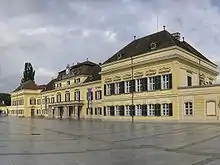Andrzej Piotr Ruszczyński
Andrzej Piotr Ruszczyński (born July 29, 1951) is a Polish-American applied mathematician, noted for his contributions to mathematical optimization, in particular, stochastic programming and risk-averse optimization.
Andrzej P. Ruszczyński | |
|---|---|
.jpg.webp) Ruszczyński in 2017 | |
| Citizenship | United States |
| Alma mater | Politechnika Warszawska, Warsaw, Poland |
| Known for | Stochastic programming, Risk-Averse Optimization |
| Awards | Dantzig Prize (2018) |
| Scientific career | |
| Fields | Mathematical optimization |
| Doctoral advisor | Jacek Szymanowski |
| Influences | Darinka Dentcheva, R. Tyrrell Rockafellar, Stephen M. Robinson, Roger J-B Wets |
Schooling and positions
Ruszczyński was born and educated in Poland. In 1969 he won the XX Polish Mathematical Olympiad.[1] After graduating in 1974 with a master's degree from the Department of Electronics, Warsaw University of Technology, he joined the Institute of Automatic Control at this school. In 1977 he received his PhD degree for a dissertation on control of large-scale systems, and in 1983 Habilitation, for a dissertation on nonlinear stochastic programming.[2] In 1992 the President of Poland, Lech Wałęsa, awarded Ruszczyński the state title of Professor. In 1984-86 Ruszczyński was a visiting scholar at the Institute for Operations Research, University of Zurich. In 1986-87 he was the Vice-Director of the Institute of Automatic Control, and in 1987-1990 he was the Vice-Dean of the Department of Electronics, Warsaw University of Technology.[3] In 1992 Ruszczyński was a visiting professor at the Department of Operations Research, Princeton University, in 1992-96 he led the project Optimization under Uncertainty at the International Institute for Applied Systems Analysis, in 1996-97 he was a visiting professor at the Department of Industrial Engineering, University of Wisconsin-Madison, and since 1997 he has been with Rutgers University, where he holds a position of Distinguished Professor at the Rutgers Business School.[4][5]
Main achievements
Ruszczyński developed decomposition methods for stochastic programming problems, the theory of stochastic dominance constraints (jointly with Darinka Dentcheva), contributed to the theory of coherent, conditional, and dynamic risk measures (jointly with Alexander Shapiro), and created the theory of Markov risk measures.[6][7][8][9][10] He authored 5 books and more than 100 research papers.[11]
He was elected to the 2017 class of Fellows of the Institute for Operations Research and the Management Sciences.[12] In 2018 Ruszczyński (jointly with A. Shapiro) received the Dantzig Prize[13][14] of the Society for Industrial and Applied Mathematics and the Mathematical Optimization Society.[15]

Selected books
- Ruszczyński, Andrzej; Shapiro, Alexander (2003). Stochastic Programming. Handbooks in Operations Research and Management Science. 10. Philadelphia: Elsevier. p. 700. ISBN 978-0444508546.
- Ruszczyński, Andrzej (2006). Nonlinear Optimization. Princeton, NJ: Princeton University Press. pp. xii+454. ISBN 978-0691119151. MR 2199043.
- Shapiro, Alexander; Dentcheva, Darinka; Ruszczyński, Andrzej (2009). Lectures on stochastic programming. Modeling and theory. MPS/SIAM Series on Optimization. 9. Philadelphia: Society for Industrial and Applied Mathematics. pp. xvi+436. ISBN 978-0898716870. MR 2562798.
Most influential papers
- Ruszczyński, A., A regularized decomposition method for minimizing a sum of polyhedral functions, Mathematical Programming 35 (1986) 309–333.
- Mulvey, J. M.; and Ruszczyński, A., A new scenario decomposition method for large-scale stochastic optimization, Operations Research 43(1995) 477–490.
- Ogryczak, W.; and Ruszczyński, A., Dual stochastic dominance and related mean—risk models, SIAM Journal on Optimization 13 (2002) 60–78.
- Dentcheva, D.; and Ruszczyński, A., Optimization with stochastic dominance constraints, SIAM Journal on Optimization 14 (2003) 548–566.
- Ruszczyński, A.; and Shapiro, A., Optimization of convex risk functions, Mathematics of Operations Research 31 (2006) 433–452.
Chess composition
2nd Prize, Szachy, 1972
| a | b | c | d | e | f | g | h | ||
| 8 |  | 8 | |||||||
| 7 | 7 | ||||||||
| 6 | 6 | ||||||||
| 5 | 5 | ||||||||
| 4 | 4 | ||||||||
| 3 | 3 | ||||||||
| 2 | 2 | ||||||||
| 1 | 1 | ||||||||
| a | b | c | d | e | f | g | h | ||
1st Prize, M. Vukcevich Mem. Ty., 2004
| a | b | c | d | e | f | g | h | ||
| 8 |  | 8 | |||||||
| 7 | 7 | ||||||||
| 6 | 6 | ||||||||
| 5 | 5 | ||||||||
| 4 | 4 | ||||||||
| 3 | 3 | ||||||||
| 2 | 2 | ||||||||
| 1 | 1 | ||||||||
| a | b | c | d | e | f | g | h | ||
Under the name Piotr, Ruszczyński is known as an author of chess problems holding the title of International Master of Chess Composition of FIDE[16] (since 1988). 29 his problems of all genres were selected to FIDE Albums by the Permanent Commission of the FIDE for Chess Compositions.
To the left is one of early Ruszczyński's problems.[17] The key 1. Qh6! threatens 2. Qf8 and 3. Qd6#. After 1 ... Ke6 white still plays 2. Qf8 Kxd7 3. Qe7#. The two main variations present the idea of half-pin: 1 ... f5 2. Rd5+ Ke6 3. exf5# (using the pinning of Pg5), and 1 ... g5 2. Re7+ Kd6 3. e5# (using the pinning of Pf5). All variations end with model mates; the main two variations have identical mate pictures on different squares.
To the right is one of Ruszczyński's best known strategic threemovers.[18] The key is 1.Qf6! with the threat 2. fxg3+ Kxe1 3. Bd2#. In the two main variations, black Grimshaw intersection on the square c3 is exploited with anticipatory shut-offs from a white half battery. After 1. ... Bc3 white plays 2. Nc2! (threatening 3. Bd2#), and then 2. ... Bxf6 3. Be3# (using the anticipatory shutoff on c2), 2. ... Bxb2 3. Bxb2#, and 2. ... Be1 3. Ne3#. After 1. ... Rc3 white plays 2. Bd2! (threatening 3. Nc2#), and then 2. ... Rf3 3. Nd3# (using the anticipatory shutoff on d2), 2. ... Re3 3. fxe3#, and 2. ... Rc1 3. fxg3#.
With Jan Rusinek, Ruszczyński co-authored the book: 64 Polish Chess Compositions. Warszawa: Polski Związek Szachowy. 1989.
References
- XX Olimpiada Matematyczna (rok szk. 1968/69), http://om.edu.pl/stara_wersja/20.html Archived 2016-03-04 at the Wayback Machine
- "Niektóre własności i metody rozwiązywania nieliniowych zadań programowania stochastycznego," Prace Naukowe - Politechnika Warszawska: Elektronika, Wydawnictwa Politechniki Warszawskiej, 1982.
- History / About us / Faculty / FEIT - The Faculty of Electronics and Information Technology home page
- "Archived copy". Archived from the original on 2013-05-07. Retrieved 2012-12-29.CS1 maint: archived copy as title (link)
- Birge, John; Louveaux, Francois (2011). Introduction to stochastic programming. New York, NJ: Springer. pp. xxvi+485. ISBN 978-1461402367. MR 2807730.
- Kall, Peter; Mayer, János (2011). Stochastic Linear Programming: Models, Theory, and Computation. New York, NJ: Springer. pp. xx+426. ISBN 978-1441977281. MR 2744572.
- Higle, J. L., Stochastic programming: Optimization when uncertainty matters, Tutorials in Operations Research, INFORMS 2005, ISBN 1-877640-21-2.
- Rockafellar, R. T., Coherent approaches to risk in optimization under uncertainty, Tutorials in Operations Research, INFORMS 2007, ISBN 978-1-877640-22-3.
- Sagastizabal, C., Divide to conquer: decomposition methods for energy optimization. Mathematical Programming, Ser. B, 134, 2012, 187-–222.
- Andrzej Ruszczyński - Google Scholar Citations
- Fellows: Alphabetical List, Institute for Operations Research and the Management Sciences, retrieved 2019-10-09
- SIAM
- MOS
- Dantzig Prize Ceremony, Bordeaux 2018
- International masters
- Problem 285, FIDE Album 1971-1973, Sahovska Naklada, Zagreb, 1978
- Odette Vollenweider, "Gleiche Inhalte in Zwei- und Dreizügern", Die Schwalbe, Deutsche Vereinigung für Problemschach, Heft 223, Februar 2007 (http://www.dieschwalbe.de/schwalbe223.htm).
External links
- Homepage of Andrzej Ruszczyński at Rutgers University. Contains biography, research overviews, lectures and presentations.
- Rutgers Business School article on Ruszczyński.
- Andrzej Piotr Ruszczyński's results at International Mathematical Olympiad